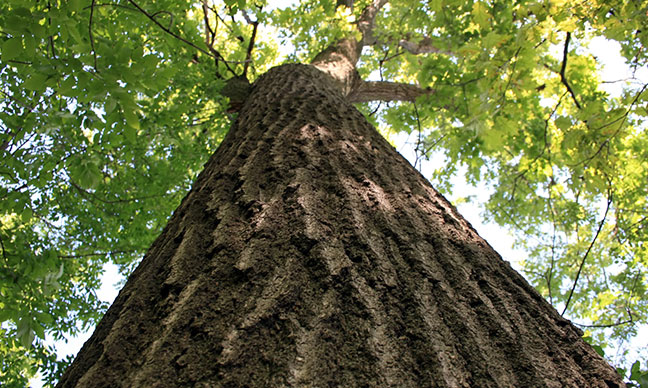Climate, site quality, and the tree’s age are predisposing factors for the acute oak decline. This emerging disease was first observed in the late 20th century and it can kill trees in 4-6 years since the first symptoms show up. Multiple agents, such as root rot, borers, and defoliating insects are contributing factors that just cause more damage and stress to the trees.
Keep reading to find out about oak decline treatment and what you can do to prevent the disease from spreading!
Related Posts: Wood Borers In Trees & Signs Of A Stressed Oak
Acute Oak Decline – Symptoms, Causes, and Treatment
The first symptom of acute oak decline is the progressive dieback from the tips of the branches. Other signs you should pay attention to are premature autumn leaf color, development of epicormic sprouts on large branches, sparse foliage, and foliage that looks dead but is still on the tree. In some cases, you might notice the diameter growth reducing just before the first symptoms appear. Dieback symptoms are common in defoliated trees that refoliate the same season.
Related Posts: Signs Of Sick Tree & Tree Branches Dying
The tree mortality occurs 4-6 years after the initial stress, so the decline process is usually very slow. Southern red oak, scarlet oak, and black oak are most susceptible to developing this disease. Still, other species in the red oak and white oak families can also experience oak decline.
We still don’t have a cure for the AOD, so we also don’t have an established oak decline treatment. However, there are some preventative measures you may consider, so check them out below. The main idea is to slow down the process of declining and to stop the spreading of bacteria and pathogens to other oak trees in the area. All of these are recommended by tree services Fort Worth.
Related Post: Oak Gall Treatment
1. Improve the Existing Forest
Remove some of the larger trees to thin the forest. Doing this will also develop oak seedlings and saplings. In addition, selectively cut smaller trees from the midstory. Consider this step to be a long-term solution to preventing the disease. Also, these options can be useful for areas that are vulnerable to decline.
2. Avoid Using Timber from the Infected Trees
We are still not sure whether this disease affects timber properties. So, be cautious if you’re thinking about using it for something. In addition, experts are not sure how long the bacteria can survive in the affected trees and their wood.
3. Don’t Prune the Tree
Unless dead branches pose immediate safety and health risk, pruning infected trees is discouraged. Pruning an infected tree can weaken the tree since you will be reducing its possibilities of overcoming the bacterial infection. Also, you will be increasing the risk of spreading the disease to other trees. Secondary infections are also possible after pruning. If you, however, need to prune the tree, make sure to contact a tree service Texas to avoid damaging the tree.
4. Felling
In some cases, felling is the appropriate option. However, for this kind of oak decline treatment, you need to follow some general rules of thumb. For example, avoid felling if the tree is wet as you may just spread the pathogens. Also, after felling, make sure you strip the outer bark and sapwood of those trees that are already in late stages of decline. Before you leave the site, disinfect the bark chipper to prevent bacteria from spreading.
5. Don’t use the Parts of Infected Trees
Obviously, you want to avoid using bark chips or other parts for soil or compost conditioner, and mulch. Also, felled trees should be avoided as sources of deadwood habitat on sites where you plan to plant new trees. Make sure you strip the trees of sapwood and bark before you think about moving branches and logs off the site.
6. Biosecurity
Make sure you disinfect the pruning and felling equipment after using it. The reasons are obvious; you want to avoid spreading the bacteria and other pathogens to other oak trees. Also, bear in mind to clean the tires of your vehicle and the soles of your footwear before you leave the site. The debris and mud that get piled up may carry the bacteria and pathogens that you can easily spread and speed up the oak decline in other trees.
Local Tree Experts Overview
Acute oak decline is an emerging disease that we don’t have a cure for. However, there are a few things you can do to prevent the disease from spreading and to slow down the development. Keep in mind that old trees are more susceptible to damage, so make sure you contact your local tree service if you notice some of the symptoms. Also, when it comes to felling and pruning, it is probably better if you’re unsure how to do it properly.




